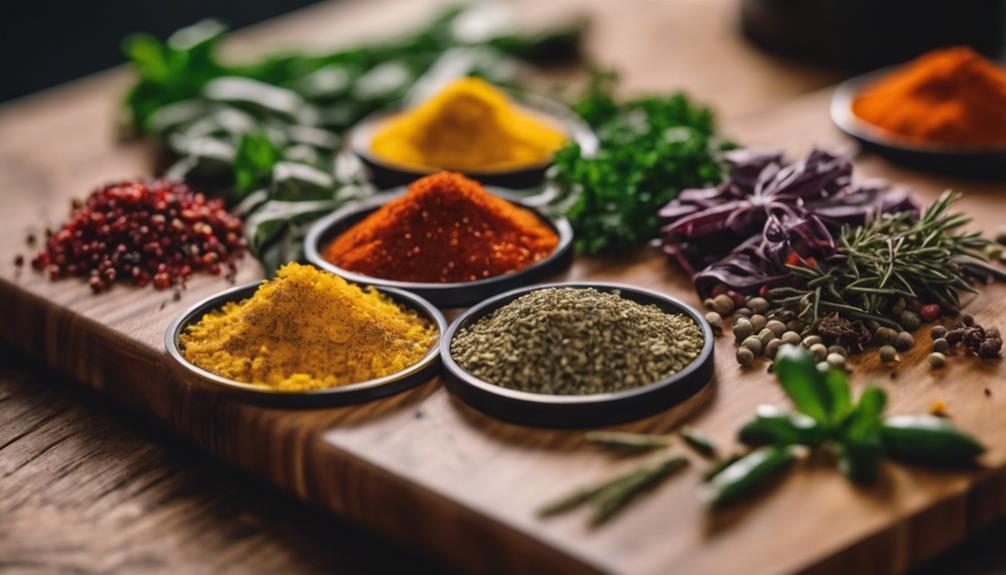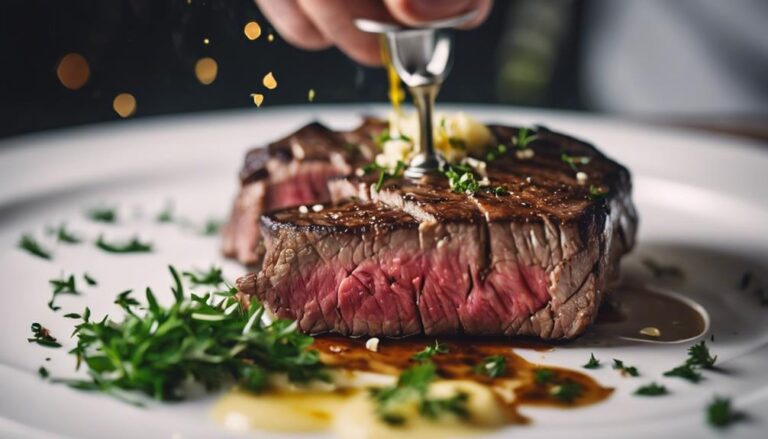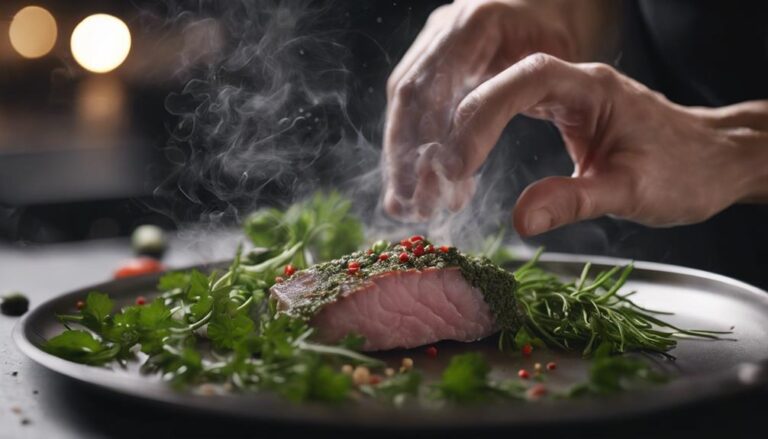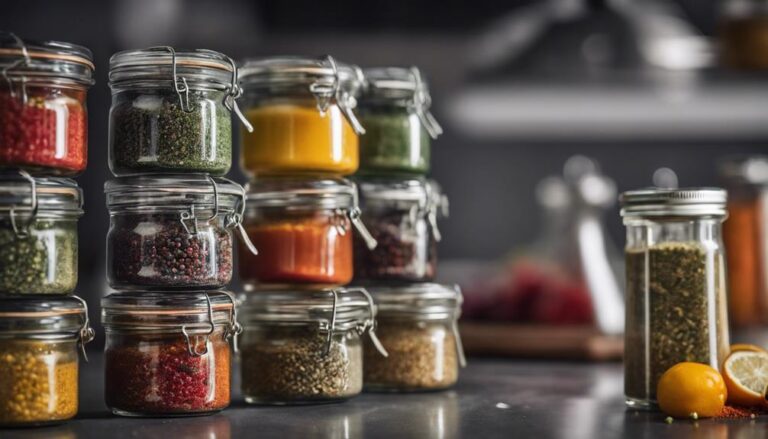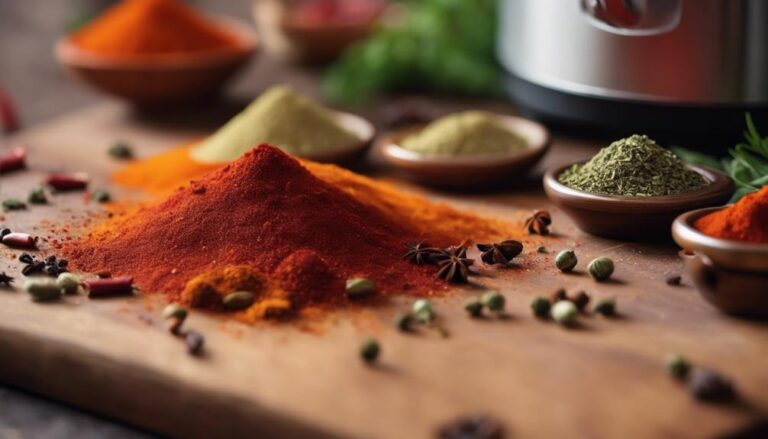Top Seasoning Tips for Delicious Sous Vide Meals
Enhance your sous vide meals with these top seasoning tips. Start with salt and pepper for flavor balance. Fresh herbs add vibrant tastes and visuals. Experiment with exotic spices for fusion flavors. Balance with acids like lemon juice for depth. Sweet options like honey or maple syrup give variety. Try dry rubs for small cuts and wet rubs for larger ones. Incorporate umami-rich ingredients for complexity. Infuse oils with herbs for robust flavors. Don't forget to season your veggies generously. For more flavorful recipes, explore our seasoning variety.
What You Will Learn Here
- Balance salt and pepper for optimal taste.
- Infuse dishes with fresh herbs for vibrant flavors.
- Experiment with exotic spices for unique taste profiles.
- Enhance flavors with acids like lemon juice.
- Use sugar or honey to balance and sweeten meals.
Salt and Pepper Basics
Enhance the flavors of your sous vide meals by mastering the basics of salt and pepper seasoning. In sous vide cooking, salt and pepper play vital roles in elevating the taste of your dishes. Salt not only adds flavor but also helps to tenderize the protein being cooked. On the other hand, pepper introduces a subtle heat that can enhance the overall dining experience.
When seasoning your sous vide meals with salt and pepper, it's essential to strike a balance between the two. Too much salt can overpower the dish, while too little can leave it bland. Similarly, an excess of pepper can make the meal overly spicy, while a lack of it might result in a flavorless outcome. Experimenting with different amounts of salt and pepper will help you find the perfect combination that suits your palate.
Utilizing Fresh Herbs
Fresh herbs like rosemary, thyme, and basil can infuse your sous vide dishes with vibrant and aromatic flavors. Adding these fresh herbs to your sous vide bag or as a finishing touch after cooking can bring a burst of freshness to your meal, delighting the senses of those you serve. The presentation and taste of your dishes are elevated when you utilize fresh herbs, creating a dining experience that's both delicious and visually appealing.
Experimenting with different combinations of fresh herbs allows you to craft unique and flavorful sous vide meals that will impress your guests. Not only do fresh herbs enhance the taste of your dishes, but they also provide a natural and healthy way to season your food, adding depth and complexity to the flavors without the need for excess salt or artificial additives. By incorporating fresh herbs into your sous vide cooking, you can create dishes that are both nutritious and bursting with delicious herbaceous notes.
Exploring Exotic Spices
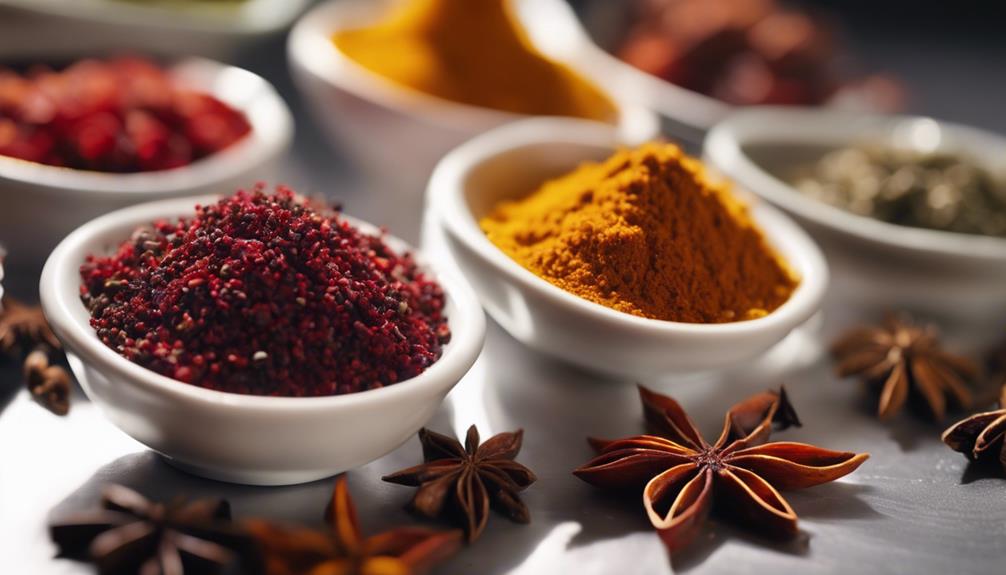
You can take your sous vide dishes to new heights by experimenting with exotic spices like saffron, sumac, cardamom, and star anise. Infusing these unique flavors into your meals can create a culinary experience that delights your taste buds.
Spice Pairings
Experimenting with exotic spices in your sous vide cooking can open up a world of flavor possibilities that will tantalize your taste buds. Spice pairings can take your dishes to the next level, such as combining cumin and coriander for a Middle Eastern twist or turmeric and cardamom for an Indian-inspired taste. Here is a helpful table with some exotic spice pairings to inspire your culinary creations:
| Spice 1 | Spice 2 |
|---|---|
| Cumin | Coriander |
| Turmeric | Cardamom |
| Sumac | Za'atar |
| Smoked Paprika | Szechuan Peppercorns |
| Harissa | Star Anise |
Mix and match these exotic spices to create fusion flavors that will delight your guests' palates.
Flavor Infusions
Wondering how exotic spices like sumac, za'atar, and berbere can transform the flavors of your Sous Vide Chicken? These global spices offer a world of bold and unique tastes that can elevate your cooking to new heights.
Before cooking your Sous Vide Chicken, season it with spices such as turmeric, cardamom, and star anise for a depth of flavor that will impress your guests. By incorporating these exotic spices, you can create restaurant-quality dishes right in your own kitchen.
Don't hesitate to explore the domain of international flavors; experimenting with these exotic spices can introduce exciting new taste profiles to your sous vide meals. Step out of your comfort zone and let these spices work their magic!
Balancing With Acids
To enhance the overall flavor profile of your sous vide meals, consider balancing the seasoning with the addition of acids like lemon juice or vinegar. Acids such as these bring brightness and balance to your dishes, elevating the taste of your sous vide recipes.
When you balance acids with other seasonings, you create a harmonious blend that enhances the overall flavor experience. Not only do acids add a tangy contrast to rich or savory flavors, but they also help tenderize proteins, making your meals even more enjoyable to eat.
Sweetening the Deal
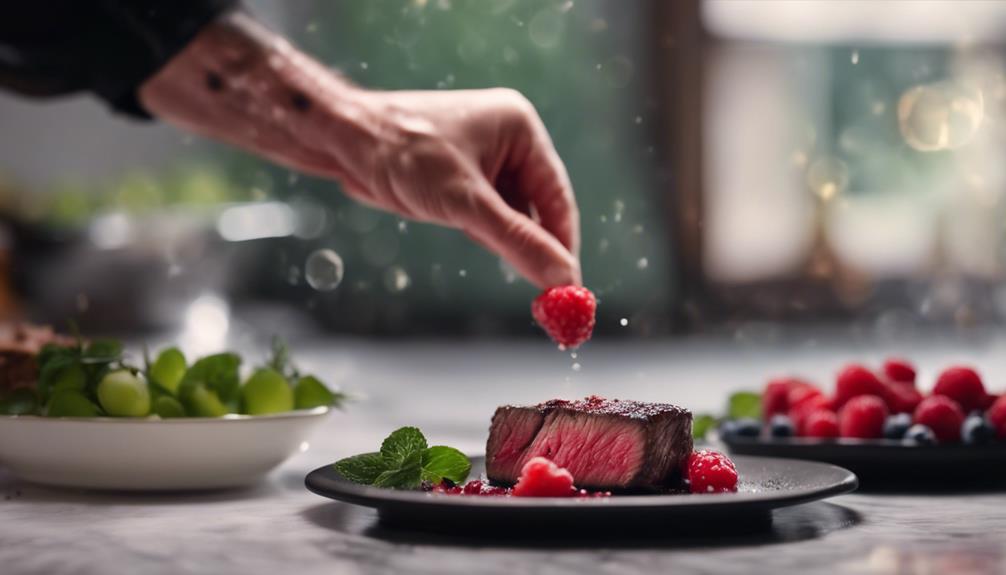
When sweetening your sous vide meals, remember that sugar can add balance, honey can provide a glossy glaze, and maple syrup can offer depth to your dishes.
Experiment with these sweet elements to elevate the flavors and create a well-rounded taste experience in your cooking.
Sugar for Balance
Balancing flavors in your sous vide meals is crucial, and sugar plays an essential role in achieving this harmony. When using sugar in your seasoning, consider the following:
- Sugar is a key player in harmonizing flavors, enhancing the overall taste profile.
- It helps to balance out the saltiness in your dishes, creating a well-rounded flavor.
- Different sugar varieties like white sugar, brown sugar, or honey can be utilized for diverse taste experiences.
- Sugar aids in caramelization and browning of proteins during the sous vide cooking method, resulting in deliciously flavorful results.
Remember to use sugar sparingly to prevent overpowering the dish's taste, ensuring a perfectly balanced meal for those you serve.
Honey for Glaze
Enhance your sous vide meats with a sweet and sticky glaze by incorporating honey into your seasoning arsenal. Honey not only adds a delightful sweetness but also caramelizes beautifully when seared after sous vide cooking. It helps balance out savory flavors, elevating the overall taste of your dish. When using honey, consider combining it with other seasonings for a more complex and delicious finish. Experiment with different types of honey to discover unique flavor profiles that suit your taste preferences. Remember that the cooking time and submerging the food in honey are essential steps to guarantee the perfect glaze. Try the table below for a visual guide:
| Honey Glaze Tips | |
|---|---|
| Cooking Time | Varies |
| Submerging the Food | Important |
Maple for Depth
To add depth and sweetness to your sous vide meals, consider incorporating maple syrup as a seasoning option. Maple syrup not only adds a touch of sweetness but also enhances the overall taste profile of your dish. When cooking with maple syrup, it can caramelize beautifully, creating a rich and flavorful crust that will elevate your meal to a whole new level.
This versatile ingredient balances savory flavors with its natural sweetness, making it a perfect complement to a wide range of proteins, vegetables, and even desserts.
- Works well with a variety of proteins and vegetables
- Enhances the overall taste profile
- Creates a rich and flavorful crust when caramelized
- Balances savory flavors with a hint of natural sweetness
Marinating for Flavor Infusion
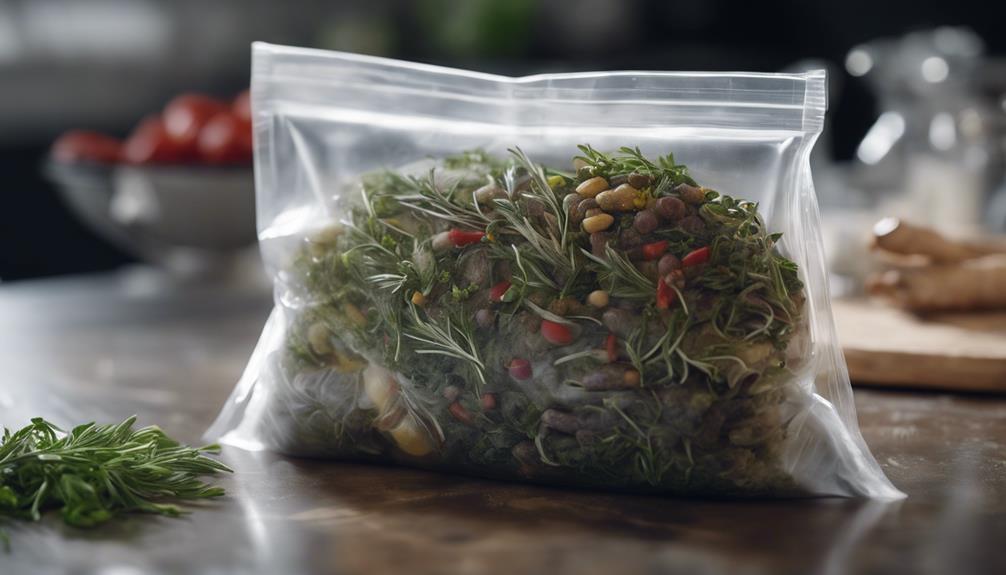
For best flavor infusion when marinating your chicken for sous vide cooking, make sure thorough coating of the meat in the marinade to achieve even distribution of flavors. Marinating allows the flavors to penetrate the surface of the chicken, enhancing its taste. Acidic marinades not only add flavor but also help tenderize the meat, making it juicier and more succulent. Remember that marinating in the refrigerator is vital to prevent bacterial growth and guarantee food safety.
To get the best results, aim for longer marination times as they result in more flavorful chicken. The key is to make certain that every part of the chicken is fully coated in the marinade. This will help ensure that the flavors are evenly distributed throughout the meat, creating a delicious and well-seasoned dish. So, take the time to marinate your chicken properly before sous vide cooking to elevate its taste and impress your guests with a flavorful meal.
Dry Rubs Vs. Wet Rubs
When deciding between dry rubs and wet rubs for seasoning your sous vide meals, consider the size of the meat cuts and the desired flavor profile. Dry rubs involve applying a mixture of spices like paprika and garlic powder directly onto the meat's surface, enhancing the taste as it cooks.
On the other hand, wet rubs require submerging the food in a brine solution to boost tenderness and flavor. Here are some points to keep in mind when choosing between dry rubs and wet rubs:
- Dry rubs are excellent for smaller cuts of meat, ensuring a flavorful crust forms during cooking.
- Wet rubs are best suited for larger cuts, infusing the meat with moisture and seasoning throughout.
- Dry rubs typically contain garlic powder, paprika, and mustard seed for a robust flavor profile.
- Wet rubs involve creating a brine solution with precise salt percentages for the best results.
Enhancing Umami Notes
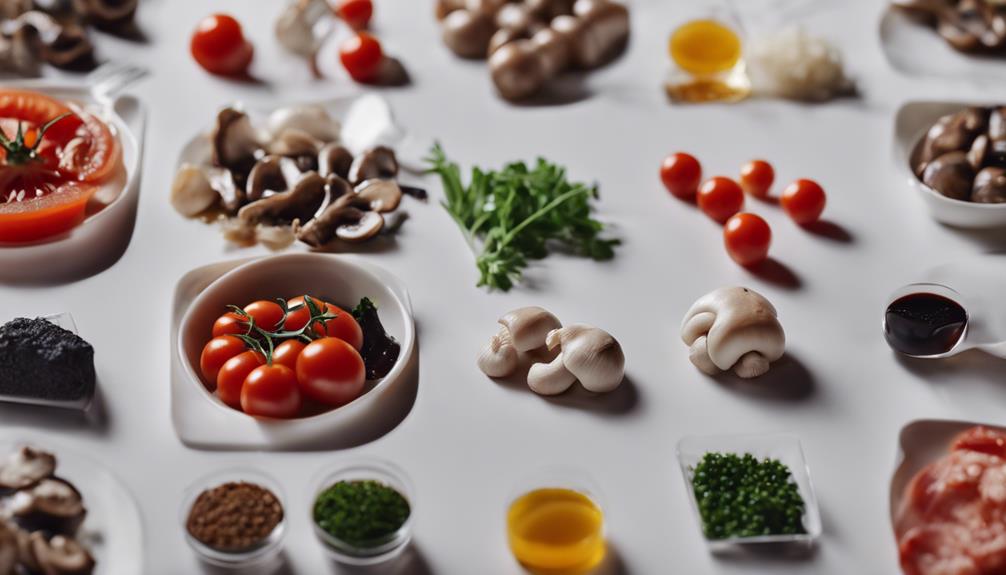
Enhance the depth and richness of your sous vide dishes by incorporating umami notes from ingredients like soy sauce, miso, mushrooms, and tomatoes. Umami, known as the fifth taste, can truly elevate your culinary creations. When using the sous vide method, these umami-rich ingredients infuse their savory essence into your dishes, creating a symphony of flavors on your palate.
To enhance the umami profile further, consider combining these ingredients with complementary seasonings. For instance, blending soy sauce with garlic and ginger can add layers of complexity to your marinades. Mixing miso with a hint of mirin and sesame oil can bring a delightful richness to your sous vide preparations. Additionally, experimenting with other umami sources such as fish sauce or Parmesan cheese can take your sous vide meals to the next level of deliciousness.
Infusing Oils for Aromatic Flavors
To infuse oils for aromatic flavors in your sous vide dishes, consider incorporating herbs and spices like rosemary, thyme, basil, and garlic through a gentle heating process. This simple technique allows the oil to soak up the essence of the herbs and spices, enhancing the overall taste of your meals.
Here are some tips to help you infuse oils effectively:
- Choose Quality Ingredients: Select fresh herbs and high-quality spices to guarantee a robust flavor profile.
- Control the Heat: Heat the oil and herbs gently over low heat to prevent burning and maintain the delicate flavors.
- Be Patient: Allow the herbs and spices to steep in the oil for at least 5-10 minutes to fully extract their aromatic essence.
- Store Properly: Once infused, let the oil cool before storing it in airtight containers for future use.
Seasoning Sous Vide Vegetables
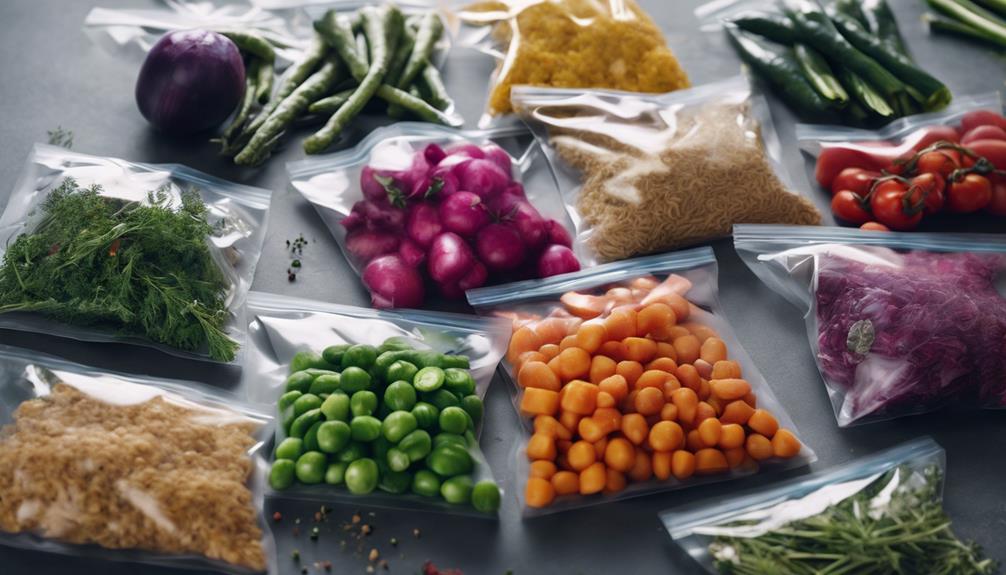
When seasoning sous vide vegetables, consider flavorful combinations and the timing for best results.
Try mixing garlic powder, onion powder, herbs like thyme and rosemary, or spices like paprika and cumin to enhance the natural flavors.
Experimenting with different seasonings can lead to unique and delicious outcomes for your sous vide vegetable dishes.
Flavorful Vegetable Combinations
For flavorful sous vide vegetables, consider experimenting with a variety of seasonings to enhance their natural tastes and textures. When seasoning vegetables in the sous vide bath, remember to:
- Use garlic: Infuse your vegetables with rich and savory flavors.
- Incorporate herbs like thyme and rosemary: Add a fragrant and earthy aroma to your dishes.
- Try spices like paprika: Bring a hint of smokiness and complexity to your vegetables.
- Add acidic ingredients like balsamic vinegar or citrus zest: Brighten up the flavors of your sous vide vegetables with a touch of acidity.
Timing for Best Results
Season your sous vide vegetables with the seasonings of your choice before sealing them in the bag for the best flavor infusion and seasoning absorption during cooking. Salt and pepper generously to enhance their natural taste, and consider herbs like thyme, rosemary, or basil for added depth. Avoid acidic marinades as they can affect the texture.
When using Sous Vide, timing is essential – vegetables typically need 30 minutes to 1 hour at 183°F (84°C) to achieve the desired tenderness while retaining their nutrients. Unlike chicken breasts, vegetables cook faster, so be mindful of the time.
Experiment with different seasoning combinations to discover the perfect taste profile for your sous vide vegetables.
Frequently Asked Questions
How Do You Make Sous Vide More Flavorful?
To make sous vide more flavorful, enhance it with flavor infusion through various seasonings like salt, pepper, herbs, and spices. Experiment with different aromatics pairings to create unique tastes. Share your secrets with the community for inspiration.
How Do You Season Food for Sous Vide?
To season food for sous vide, enhance flavor infusion by using salt, pepper, and rubs tailored to the type of food. Control temperature precisely for best results. Explore brining methods and store-bought seasonings for convenience and variety. Share recipes for inspiration and connection.
What Is the Best Seasoning for Sous Vide Steak?
When seasoning sous vide steak, you can create flavorful marinades and unique spice blends. Start by experimenting with salt, pepper, garlic powder, and herbs like rosemary or thyme. Mix them well for a delicious outcome.
Should You Season Meat Before or After Sous Vide?
You should definitely season meat before sous vide for evenly infused flavors. Timing matters; pre-seasoning elevates taste. Marinade options enhance richness. Experiment with seasoning techniques to find your perfect match. Enjoy the delicious results of your sous vide efforts!
Conclusion
Now that you've mastered the art of seasoning your sous vide meals, get ready to take your culinary skills to the next level.
Experiment with different combinations of salt, pepper, herbs, spices, acids, sweeteners, rubs, and oils to create mouthwatering dishes that will impress even the most discerning palates.
With these top seasoning tips in your arsenal, your sous vide meals will always be bursting with flavor and perfectly seasoned to perfection.
Happy cooking!
